Sun, Sky and MX-5
We welcome Mazda's excellent, fun little roadster to the fleet - but will the charm wear off when the weather turns?
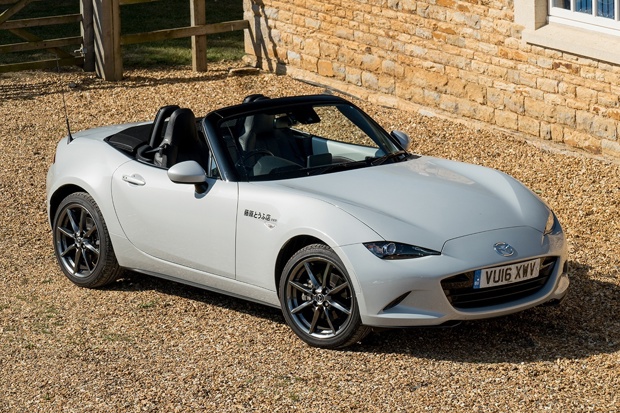
Date: 25 July 2016 | Current mileage: 4081 | Claimed economy: 40.9mpg | Actual economy: 35.6mpg
It’s easy to be enticed by the Mazda MX-5. It has sporty styling, a retractable roof, fun performance and it gets great reviews in the motoring press – plus it’s affordable. But as fun as the idea of open-topped motoring is on a sunny day, is the little Mazda roadster a car you can live with in the long term?
That’s what we aim to find out with our new, top-spec Sport Nav 2.0-litre. It almost misses the point of being a low-budget sports car with a price tag of more than £25,000 (the basic model is £18,495) – but it does come with a lot of gadgets including navigation, leather upholstery, heated seats, auto lights and wipers, lane departure warning and a high quality BOSE audio system.
Because it’s a 2.0-litre, rather than a 1.5, it also has Bilstein suspension dampers, a limited-slip differential, larger 17-inch alloy wheels and a front strut brace, all of which are designed to sharpen up the handling and make the MX-5 a bit more focused – not that the 1.5-litre is in any way dull to drive.
There aren’t many options on our MX-5, but there aren't many to choose from anyway. It has £500 metallic paint and the £400 Safety Pack, which adds auto-dipping headlights, blind spot monitoring and rear cross traffic alert. With the roof up those options are handy, since over-shoulder visibility is poor.
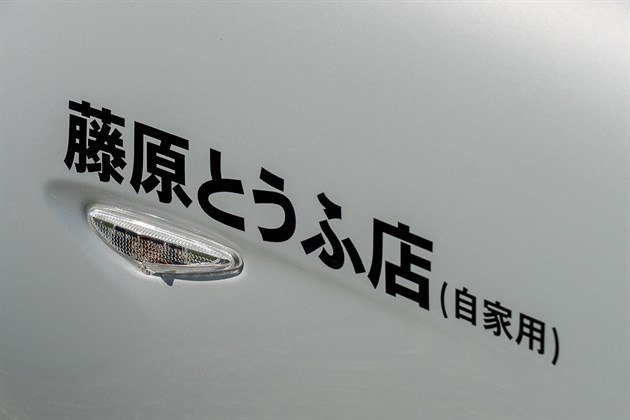
A personal touch
Along with some great colours like Soul Red, the MX-5 is available in three variations of what is essentially white – Arctic gloss, Crystal pearlescent and Ceramic, the latter of which I chose. It’s my personal favourite colour for the MX-5, since it manages to look really vibrant in the sun, but then turns a moody sort of grey when the sky is overcast.
Once the car arrived I decided to add a custom touch with vinyl graphics on the wings, which I can peel off when I get bored of them. They’re a reference to a famous Japanese car TV and comic book franchise called Initial D, in which the hero drives a plain-looking Toyota from his father’s tofu shop with the same text printed down the side.
So far the MX-5 has been nothing but fun – but we’ve had the weather for it. Raising and lowering the roof takes just a second and can be done from the driver’s seat so long as the car isn’t moving, so if the weather takes a turn for better or worse it’s easy to make the most of whatever the sky has decided to do.
It’ll be interesting to see how the MX-5 fares when the weather deteriorates. Will I still enjoy driving what is a very small, quite cramped and impractical car when the roof is always up, or will it be just become frustrating? I’ll find out in due course. Meanwhile, I’ll make hay while the sun shines.
Is a fabric top a good idea?
The MX-5 has an extremely simple, manually-operated soft top which keeps weight down. But is it better than an electric, metal top?
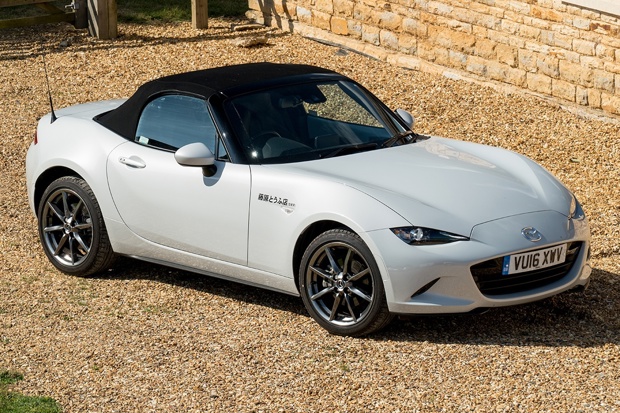
Date: 8 August 2016 | Current mileage: 4336 | Claimed economy: 40.9mpg | Actual economy: 35.5mpg
The MX-5 has spent its first two weeks attracting a lot of attention from friends and neighbours – and one of the things that seems most surprising to them is the manually-operated roof. Electrically folding soft-tops seem to be the norm these days, but Mazda has stuck with a simple, hand-operated system.
That might sound off-putting to some, but it really shouldn’t. In fact, after spending a few weeks with the MX-5 I’ve decided I prefer its basic approach, because it takes so little time. The handbook suggests you unlock the roof before getting out to fold it down and ensure it’s locked – but there is no need, it can all be done from the driver's seat.
There’s a single, chunky locking mechanism above the rear-view mirror to unlock, then with a bit of dexterity the whole roof can be chucked back and locked in place even with a seatbelt on. Obviously the car needs to be still to do this, but it takes no more than a couple of seconds, so it's straightforward enough when waiting at a set of traffic lights.
Since Mazda has worked extremely hard to keep the MX-5 light its decision to keep things simple makes sense. Electric motors and gearboxes add weight, which is bad for the nimble, fun handling the MX-5 is so well-known for. A motorised roof doesn’t really fit with the spirit of the car and besides – it would take longer than the manual system.

For all your folding hard-top needs - the RF
One of the only problems with the fabric roof so far has been keeping it looking its best. Bird droppings and dust make it look ugly and washing it is a bit of a pain, since extra care has to be taken compared to the bodywork. Still, it’s a small price to pay for miles of blue skies when the sun is shining.
It hasn’t all been warm weather and sunglasses though – and with the roof up, refinement could be better. Wind noise is to be expected with a soft top to a certain extent, but the MX-5 would definitely benefit from a bit more insulation to make long distance driving a more relaxed.
Mazda has a more refined MX-5, though. Called the MX-5 RF it has coupe-like styling and a targa style hard top that folds away behind the seats, a process that takes 12 seconds. Obviously it's heavier than the MX-5 and its design means it isn't quite as open top, but for many buyers it will hold more appeal, since it should be more secure and will be easier to keep looking its best.
An automatic transmission option is offered in the RF too – which isn’t the case with the fabric-topped MX-5. The suspension has been tweaked and some extra sound insulation has been added to make the RF more refined – so think of it as a cruiser, rather than a sports car.
Why is the MX-5 so good to drive?
The MX-5 has a longstanding reputation for being a great drivers car - but what makes it so much fun?

Date: 22 August 2016 | Current mileage: 4635 | Claimed economy: 40.9mpg | Actual economy: 41mpg
My Mazda MX-5 might be thoroughly modern, with its angular styling and touchscreen system, but the models success over the past 30 years is down to a very old-fashioned formula. It’s lightweight, has a front-mounted engine, rear-wheel drive and balanced weight distribution, just like British roadsters dating back to the 1960s.
The result is fun, enjoyable handling on the road – which is amplified by well-placed and weighted controls. The gear change has a short, chunky and accurate throw, the pedals are well-spaced and the steering has perfect weighting and feel, providing a confidence-inspiring level of feedback and precision. Through corners the MX-5 is a fantastic car.
However, unlike a hot hatch, the MX-5 feels like it was made for driver enjoyment from the get-go, rather than adapted for it from a mundane, everyday town car. The seating position is low to the floor, amplifying the sensation of speed, while the suspension transfers plenty of feedback to the driver’s seat, which makes the driving experience all the more involving.
The combination of all these details results in a car that is great on the road. Even at sensible, everyday speeds the MX-5 feels involving and exciting – it doesn’t need to be taken to a circuit to be enjoyed, nor does it need to be pushed to dangerous speeds to deliver thrills. It works very well on Britain’s notoriously twisty, uneven roads.
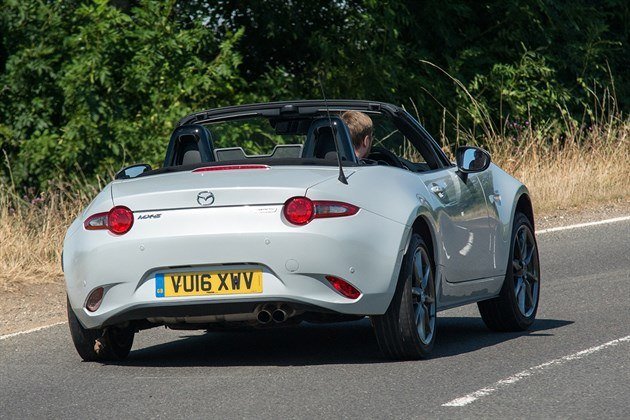
Mazda sells the MX-5 with either a 1.5-litre or 2.0-litre engine – my car is fitted with the latter. Despite its capacity it only produces 160PS, which is down on plenty of cheaper cars including the Ford Fiesta ST, which has a torquier, turbocharged engine with 182PS. But the MX-5 doesn’t feel any worse for it.
That’s partly because, again, Mazda has engineered the engine to deliver excitement even if it isn’t doing much work. The exhaust sounds subtle but great, while the engine soars crisply and smoothly from a standing start right through to the redline. Acceleration from 0-62mph takes 7.3 seconds, which is swift if not outright fast.
Picking the 2.0-litre engine also adds Bilstein suspension dampers, which are quite firm without being uncomfortable, along with a limited slip differential. This stops the rear wheels spinning independently of one another, so there is better traction from a standing start. It also sharpens up the handing when powering out of bends.
That said, the 1.5-litre is still fantastically fun to drive, despite having a lower power output of 131PS. It loses the differential and Bilstein dampers, but unless you are a particularly spirited driver there are few occasions on which you’ll miss either. Whichever engine you choose, you’ll be getting one of the most enjoyable cars available at any price.
Meet the parents
I recently had the chance to drive the old and new MX-5 back to back. How far have things come in nearly 30 years?
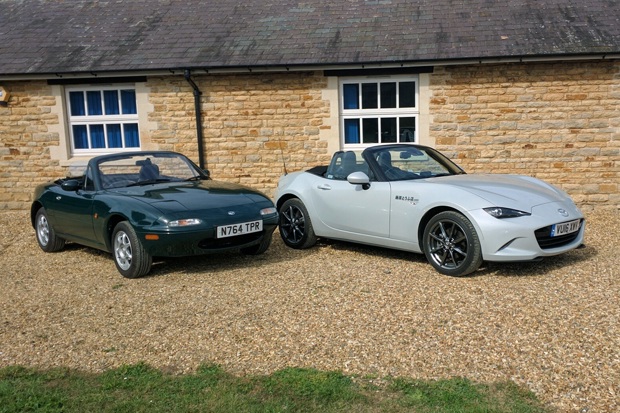
Date: 5 September 2016 | Current mileage: 5009 | Claimed economy: 40.9mpg | Actual economy: 41mpg
The original MX-5, launched in 1989, is old enough to be considered a classic car these days. Consequently, it made sense for us to have a catch up with the MK1 – or NA model, to use the language of an MX-5 aficionado – for the review on Honest John Classics, which can be found here.
That meant the perfect opportunity to compare old with new – and to see how much of the original car’s personality has made it to the latest (ND) version of the car. Even at a glance it’s easy to see these cars are related. They have the same proportions and are very similar in size, though the original car is more cleanly styled.
One of the original cars’ strongest identifying features are the pop-up headlights, which aren’t allowed on modern cars for safety reasons. But the slim, angular lights on the new car still look the part and the tail lights pay homage to the original cars’ while still feeling up-to-date.
Inside, the first-generation MX-5 is surprisingly roomy. There is more elbow and leg room in the old car than in the current model – but again that’s down to safety. The new car is stiffer and made of stronger metal with larger crumple zones to provide better protection in all kinds of crashes. That said, the driving position feels exactly the same in both cars.
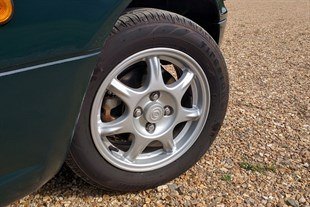
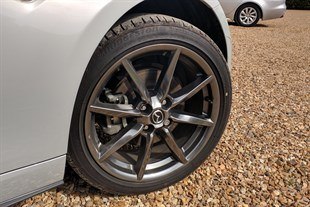
Bigger wheels are better
The steering wheel, gear lever and pedals are placed so similarly they could almost have been lifted from the old car and dropped directly into the new one. But on the road the two models feel surprisingly different – and it’s here where years of improvement and constant tweaking really show.
The old MX-5 creaks, rattles and doesn’t feel all that composed through corners, with noticeable body flex – but the ingredients are all there. It’s direct, nimble and provides plenty of feedback to the driver, particularly through the unassisted steering. That’s all well and good on the move, but not so much fun when trying to park.
The roof mechanism is simpler in the new car, with one chunky locking lever instead of two smaller, trickier-to-operate levers on the original car. The roof is easier to get back into place on the new car too, since it’s spring-loaded to make it easier to access from the cabin – it takes just a few seconds.
Purists might grumble about the various assistance systems like power steering and traction control on the new car, but after spending some time in the original I’m happy I don’t have to live with it. The new car manages to retain much of the personality that made the original so great, but it’s easier to live with day to day. So it should be, really…
Fiat or Mazda?
The Fiat 124 and Mazda MX-5 are very similar, using many identical parts. So which one is best?

Date: 19 September 2016 | Current mileage: 5009 | Claimed economy: 40.9mpg | Actual economy: 41mpg
A long time ago in an Italy far, far away, Fiat made a little two-seat sports car called the 124 Spider. In many ways it was like the Mazda MX-5, with a light body and just enough power to entertain without breaking the bank. And then, in the 1980s, it was gone. Just in time for Mazda to introduce the first MX-5.
Fast forward to now. Mazda is still enjoying the success of the MX-5 and Fiat customers have a big appetite for retro, thanks to the 500. It’s the perfect time to relaunch the 124 Spider – and that’s exactly what Fiat has done. However, this time around they’ve paired up with Mazda, so the 124 is very, very similar to the MX-5 and is built at the same factory.
Externally the 124 is bulkier and longer, with styling that evokes the look of the original car but with a bit more muscular heft. Inside, the two cars are fundamentally identical. The dashboard layout, instrument binnacle, centre console and infotainment system are exactly the same.
That said, the Fiat does have some soft touch materials where the Mazda doesn’t, along with slightly different door cards. Under the bonnet, the Fiat 124 has a 140PS 1.4-litre turbocharged engine. In terms of power it fits in between the two Mazda engine options, but it produces 240Nm of torque from 2250rpm.

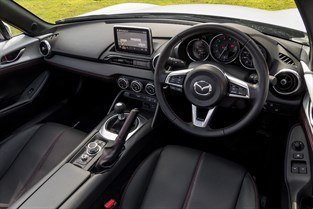
The Fiat has the same cabin, but with some plush touches
So unlike the MX-5, which thrives on revs and relishes being pushed to the redline, the 124 is easier and more flexible. The torquey, mid-range punch means the gearbox doesn’t need to be worked hard, so it’s a much more relaxed car to drive, though it is still plenty of fun on the right road.
Fiat and Mazda have managed not to tread on one another’s toes when it comes to pricing, so the 124 looks like an alternative to the Mazda, rather than a better value or cheaper car. So that means picking between the two is down to personal preference – and your own driving style.
Personally, having driven both I prefer the Mazda MX-5. It feels more fizzy, exciting and fun on a twisting road, with a soaring engine that is at its best when singing up near the top of the rev range. For my personal taste that’s more fun - and a better fit for a soft-top sports car.
But at the same time I can understand precisely why someone would pick the Fiat. Its retro styling is appealing and it’s still fun to drive, but it’s more relaxed and easy-going. If you’re more interested in sedate cruise along a coastal route than a frenetic zip up a B-road, it’s probably the better car.
Touchscreen vs Dial. Round one. FIGHT!
The Mazda MX-5 has both a rotary controller and a touchscreen. But why? And do they work well together?

Date: 3 October 2016 | Current mileage: 5396 | Claimed economy: 40.9mpg | Actual economy: 41.1mpg
Mazda has fitted a rather unusual infotainment system to the MX-5, since it has both touchscreen and physical controls. The thing is, the touchscreen bit only works when you’re sitting still – on the move you have to use the rotary controller instead. It might seem odd, but weirdly it works very well.
It makes sense, too. My previous car, the Citroen C4 Cactus, had an almost entirely touch-based interface. On the move it was a pain in the backside because you more or less had to look at it to do anything, including changing the temperature. That meant taking eyes off the road - not ideal at any time, let alone when in busy traffic.
But opting for a rotary dial with no touchscreen system is equally annoying when typing in an address or searching for a point of interest – things you’re likely to want to do when parked up before starting a journey. Mazda’s mixture of both control systems is safe and easy all at once, if a little confusing the first few times.
And so, despite initially yelling at it for not working properly and repeatedly mashing my finger into the apparently unresponsive screen, I really quite like the system in the Mazda now. It's certainly a whole lot better than the system in the Cactus, plus it comes with everything I need and it all makes logical sense. I don't really have to think about how to get to the screen I need.

This gets used more than the touchscreen
For those who make Bluetooth phone calls – the speakers for the phone are in the headrests, thanks to the Bose audio system, so even with the roof down it’s possible to hear the person at the other end of the line. I tend to ignore calls when I’m driving, so it doesn’t make much difference to me.
Same with the built-in navigation system which, while underused by me, seems to work reasonably well. More important is the support for streaming music over Bluetooth, which works perfectly. But technology progresses so quickly now that car makers are always playing catch up - and Mazda is still behind in some areas.
The most notable omissions are Android Auto and Apple CarPlay. I find Android Auto extremely useful when on the go, since there is no better alternative to Google Maps when it comes to navigation, plus I listen to all my music via Spotify. Both apps work brilliantly via the Android Auto system.
It’s standard on a lot of new cars and more or less everyone is jumping on the bandwagon, so there’s a chance that Mazda will bring it to the MX-5 in time. It’s not the end of the world anyway – the MX-5’s system works well enough for travelling around or music – it’d just be nice to have that extra level of connectivity.
Storage Hunter
Taller occupants simply won’t fit in the MX-5, but even if you can get in you'll struggle when it comes to storage.
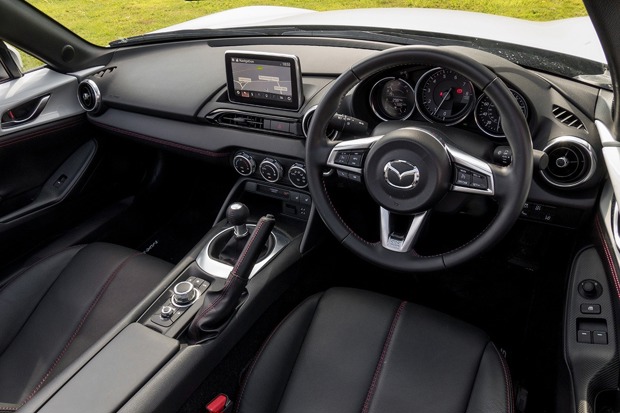
Date: 17 October 2016 | Current mileage: 5602 | Claimed economy: 40.9mpg | Actual economy: 41.1mpg
Unlike most modern cars, the Mazda MX-5 isn’t bigger than its predecessor. In fact, it’s a very small car – but to score well in safety tests it needs big, chunky doors and lots of crumple zones – so the cabin is pretty tight. Taller occupants simply won’t fit, but even if you can get in you'll struggle when it comes to storage.
There are no door pockets in the MX-5, for example, nor is there a typical glovebox. There is a rear storage area between the seats, but it’s hard to use on the move and it’s not particularly big, while the small compartment behind the gear lever is only good for a packet of sweets or some change...
There is a little anti-slip mat under the centre stack which is perfect for keeping phones still on the move, although mine doesn’t fit because it’s giant. Aside from that, there’s nowhere to keep odds and ends – although the cup holders are cleverly designed.
There are two, mounted in a quick release socket between the rear seats. They’re awkward and hard to reach there, but the left one can be removed and relocated to a to the left of the centre stack. When there it’s easy to reach for the driver but, obviously, it might get in the way of a passenger, since it occupies some of the leg space.
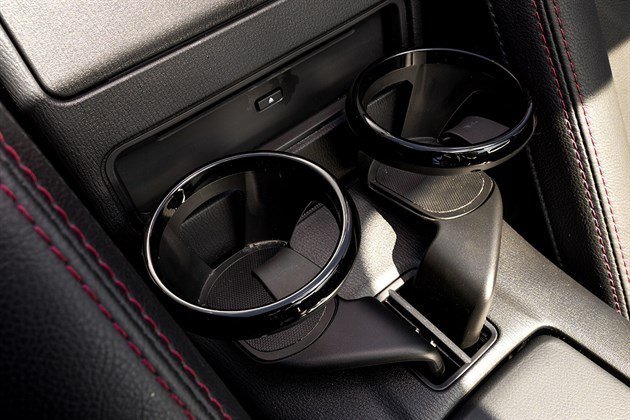
Cupholders can be moved around or taken out entirely
It’s a bit frustrating to have such limited cabin storage, but like anything it’s easy to get used to in time. Fortunately, the boot isn’t too bad at all – there’s enough space for a couple of cabin bags or a weekly shop, though access is limited compared to a hatchback, so lifting heavy stuff out isn’t easy.
Since the MX-5 has such a simple roof mechanism there is no messing around adjusting flaps or load covers in the boot, plus load space is the same with the roof up or down. That’s a big advantage over a folding metal roof, which makes the driver pick between roof-down driving or load capacity.
Most buyers will understand the practical limitations of a car like the MX-5 before they take the plunge, of course – but it is definitely worth giving the cabin a very thorough check over at the dealer, just to be sure you can live with such tight space and limited storage areas.
Me? Aside from the odd annoyance when buying snacks at motorway services, the lack of storage hasn’t been a problem at all. I usually drive alone, so I can have the cup holder in its more practical location. I’ve had plenty of room for everything else, since I don’t really need anything else but my luggage, which fits in the boot.
What does the MX-5 owe to Lotus?
A lot of the MX-5's DNA is shared with the original Lotus Elan, launched in 1963. John puts on his best overalls to look on the internet and find out.
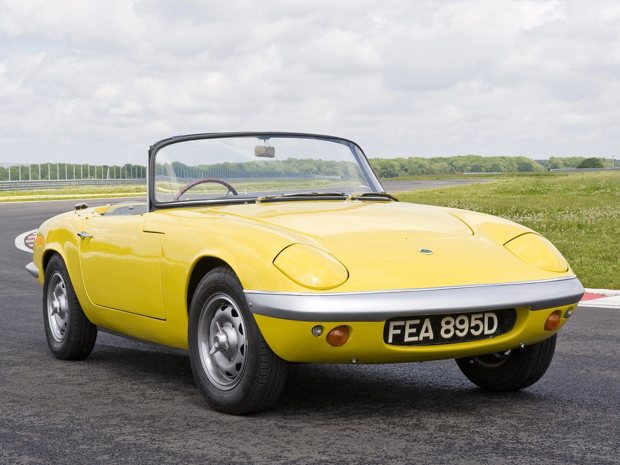
Date: 31 October 2016 | Current mileage: 6105 | Claimed economy: 40.9mpg | Actual economy: 41.8mpg
When the first-generation MX-5 was launched in 1989, it provided all the fun of a British sports car but with none of the reliability issues. Obviously, reliability is a very important part of that recipe – but what about the British sports car bit? Which cars provided the main inspiration?
In 1989, Performance Car magazine chose the Lotus Elan as the benchmark – specifically a 1963 example. The on-paper similarities between the original, 1.6-litre MX-5 and the 60s Lotus were striking, with just 0.1 seconds between them in the 0-62mph sprint and top speeds separated by just 2mph.
So how have things moved on? The original MX-5 1.6 got from 0-60mph in 8.8 seconds, while the current 1.5-litre model manages a slightly swifter 8.3 seconds. It’s like the engineers decided a figure of about eight seconds was fine in 1963 and 1989, so it should be perfect now too.
Other similarities between the Elan and the original MX-5 include the chassis layout, with a backbone for increasing rigidity while reducing weight – something that has been carried on into the current MX-5. The Elan had a twin-cam, naturally aspirated engine too, another thing that has been part of the MX-5’s DNA since the start.
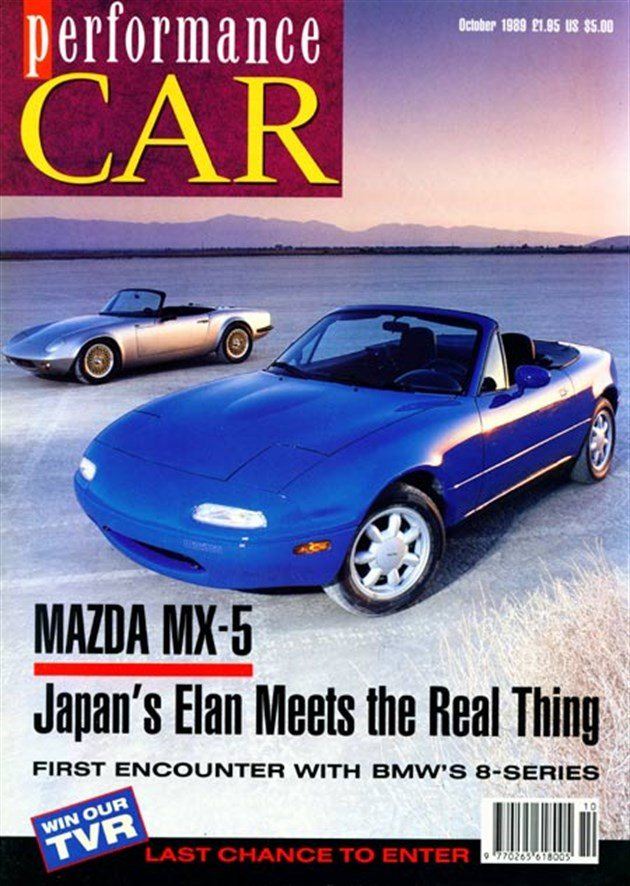
Remember magazines?
But what the Lotus Elan was really rated for was the handling – and that was down in no small part to its weight. It had none. At less than 700kg, the Elan was lighter than even a Renault Twizy. No car is that light these days, but that’s largely because modern vehicles are safer and use stronger materials.
The Elan was about as safe and sound as a balsa wood dolls house – and absolutely the last car you’d want to crash. But since it had so little inertia it gripped and cornered with more nimbleness and agility than pretty much everything else – and that grippy, agile handling was a real source of inspiration for the engineers behind the MX-5.
Mazda tried to keep the weight of the original MX-5 as low as possible, so it came in at below 1000kg. And yet, despite the constant need for more technology and more safety, the current model isn’t much heavier. Sure, it’s not as nimble as an Elan, but not much ever will be.
But with its front-engine, rear-drive layout, backbone chassis, pop-up lights and simple fabric top, the Elan was a very obvious inspiration for the first MX-5 and, as I’ve already mentioned, that car’s personality is very much alive and well in the latest MX-5. Click here to find out how the Mk1 and Mk4 compare.
Welcome to winter
The cold weather has turned up, but not even wet days and freezing temperatures can ruin the fun.
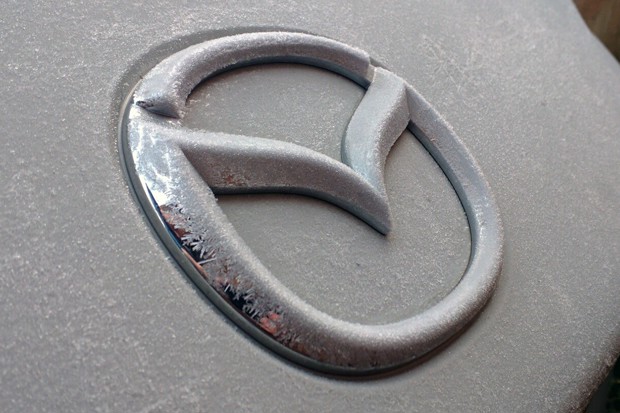
Date: 14 November 2016 | Current mileage: 7002 | Claimed economy: 40.9mpg | Actual economy: 41.7mpg
Having the MX-5 delivered in July was a great idea. The weather was good enough to have the roof down on almost every journey for the first few months – and even as things started to chill, I still managed a few trips with the top off, thanks largely to the heated seats.
But the summer really is over now – frost has started to appear on the car in morning and it’s too cold to enjoy roof-down motoring, even with heated seats. But does that mean I’ve fallen out with the MX-5? Not at all. I’m still enjoying it just as much as ever.
So far there haven’t been any truly treacherous weather conditions to deal with, but colder, damper tarmac is making a small but noticeable difference to the way the MX-5 handles. It’s particularly apparent when pulling out of junctions swiftly, where the MX-5 breaks traction a little more readily than in warm weather.
It’s not an issue, though – the traction control system allows a little slip and then gently cuts power so you can carry on without sliding out of control. In normal driving, through bends and up country roads, there is never any sense of instability nor any scary, slippery moments.
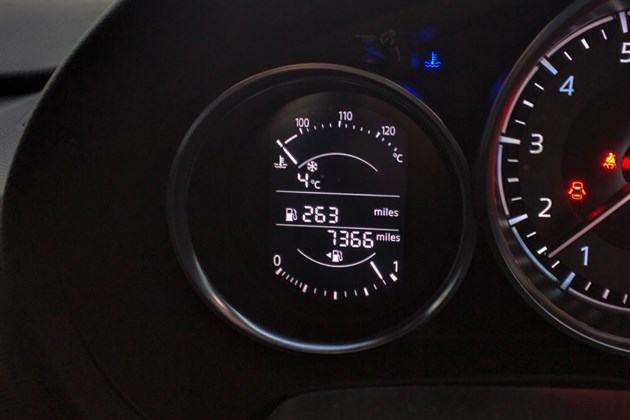
The flashing snowflake icon isn't my favourite
That’s good news. A lot of buyers will be worried about using a rear-wheel drive car in winter, but the MX-5 still feels safe and secure. That might be slightly premature, since winter is just starting and we’ve yet to have any snow, but I’m confident that the MX-5 will see me through to spring without too many problems.
One thing I have come to appreciate in the last few weeks is the heater, which warms the cabin up extremely quickly. Within just a minute or two of starting the engine the air from the vents is hot and, since the cabin is so small, it gets up to temperature very quickly.
That means getting rid of ice from the screen by running the car for a while is quite easy, but I keep an Iceplane handy too, since it’s the most effective ice scraper I’ve ever used. If I’m running late it’s quicker than sitting in the car for 10 minutes before leaving.
The MX-5 is quite prone to steaming up, probably because of the fabric roof. It doesn’t take too long to get it demisted, but it’s a little bit frustrating first thing on a cold morning. There is a heating element in the rear screen but, obviously, no wiper - so demisting that takes a little while too.
TPM Mess
Cold weather and long drives conspire to make the tyre pressure warning in our MX-5 have a breakdown...
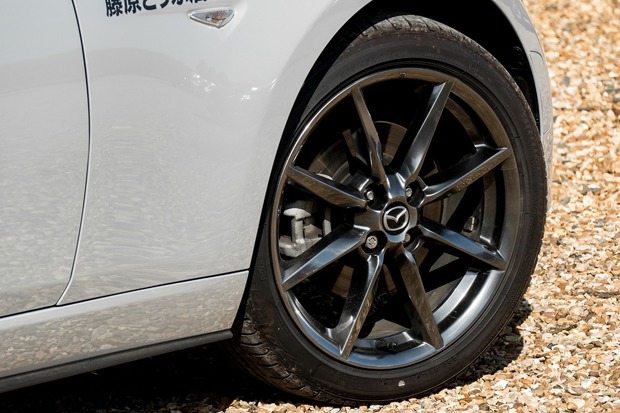
Date: 28 November 2016 | Current mileage: 7695 | Claimed economy: 40.9mpg | Actual economy: 39.8mpg
Since the cold weather has started in earnest my MX-5 has performed surprisingly well. It might be rear-wheel drive but there is plenty of traction when on the go, while the traction control system does a good job of keeping things together when pulling away from a standstill, so there’s minimal scrabbling and wheel spin.
But nothing is ever perfect – as I found out recently when driving long distance. About 100 miles into a 200 mile journey the tyre pressure warning light came on. This wasn’t accompanied by any change in driving dynamics or tell-tale flat tyre warning signs, so I chose to carry on to the nearest services rather than stopping on the hard shoulder.
And when I got there I found all four tyres to be rock solid and seemingly well-inflated. This doesn’t necessarily mean they are all perfectly up to the correct pressure, but since there was no compressor to hand I decided to reset the warning - by holding a button under the instrument binnacle – and get on my way.
That was that. I carried on all the way to my destination and made it all the way home without any further issues or warning lights – good news. But also bad news, since I completely forgot that I needed to check all of my tyre pressures and make sure they were correct for cold winter weather.
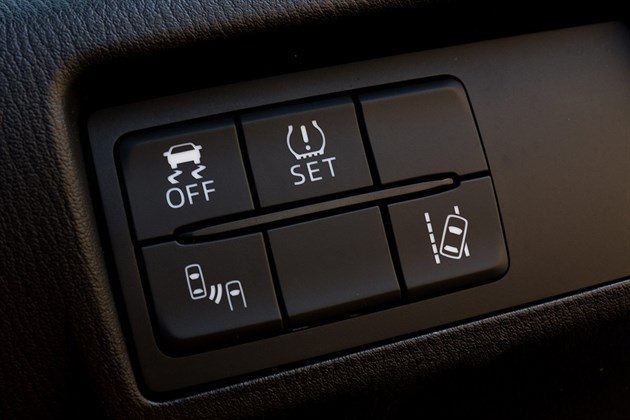
Spot the reset button...
A few days later, about 60 miles into a long drive, the same thing happened again. It was exactly the same story – I felt no change in the way the car was driving, so I chose to carry on, this time to my destination. A quick check showed all four tyres had plenty of air in, but this time I chose not to reset the warning so I was reminded to top up my tyres.
Cold winter air tends to make tyre pressures drop a touch, so I should have checked them already as a matter of course. But life gets in the way of doing things properly and the TPMS reminded me – if a little prematurely – to make sure I was safe. A few PSI was all that was needed.
The MX-5 has a basic low pressure warning system, meaning it doesn’t show the current tyre pressure. Instead it just flashes up a warning when it detects a discrepancy in pressure from wheel to wheel. This is mandatory on all cars now, but the more advanced system adds no weight and provides more functionality.
When driving along at 70mph that would have been handy, since I could have confirmed I didn’t have a potentially dangerous puncture, rather than simple low tyre pressure – and it would have told me which wheel was the culprit. Even so, I can’t complain too much – some form of tyre pressure monitoring and alert is better than none at all.
How is the MX-5 as an everyday car?
We've established that the MX-5 is brilliant fun, but how is it around town and on the motorway?

Date: 12 December 2016 | Current mileage: 7798 | Claimed economy: 40.9mpg | Actual economy: 39.4mpg
I’ve waxed lyrical about how good the MX-5 is to drive and how it provides real driver enjoyment on country roads – but how good is it the rest of the time? After all, an MX-5 might be bought for its character and dynamics, but it’s likely to spend a lot of time in town traffic and on motorways.
Pleasingly, it’s not too bad at all. If you’re willing to accept a few caveats. Around town the compact size of the MX-5 makes it very easy to get through tight gaps, into small parking spaces and down tight streets. But the low-slung driving position restricts visibility, particularly with the roof up.
Aside from the poor visibility, the driving position of the MX-5 is fine for town driving. The gearbox is slick and easy to reach, the steering isn’t too heavy and the pedals aren’t too stiff. As a result, stop start traffic isn’t too much of a hardship. If you only drive in town an auto transmission might be tempting, but unless you go for the hard-topped RF model, there isn’t one available.
The suspension isn’t great for absorbing potholes and speed bumps, but it’s not too bad, particularly if you go for the 1.5-litre model with its slightly softer settings. Stiff suspension is expected of a car like this, of course, and it’s the same story with similarly priced hot hatches which also thump over road imperfections.
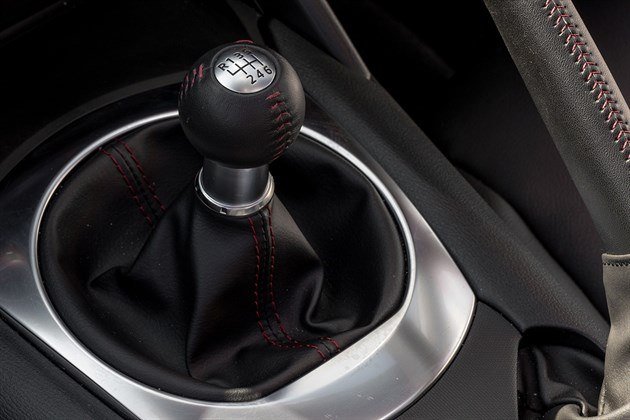
The slick transmission is easy to use in town
While the tiny size of the MX-5 might be a blessing in town it’s a curse on the motorway. Passing trucks results in some buffeting and, at least until you get used to it, the MX-5 feels like quite a vulnerable car when surrounded by huge SUVs and HGVs. The fabric roof isn’t especially well insulated from noise either, which is tiring on a long drive.
All but entry-grade SE models get cruise control with a speed limiter though, so getting through average speed camera zones isn’t too painful of an experience. And, unless you’re particularly tall, comfort shouldn’t be a major problem even on longer journeys, thanks to supportive seats.
I’ve already mentioned the lack of storage space – more on that here. In short, you can probably fit a small weekly shop in the MX-5 if you don’t have a big family. But the boot is small and there is very little storage space in the cabin. In fact, I can fit about the same amount of shopping in a scooter with a top box as I can in the MX-5 boot.
Most buyers know cars like the MX-5 have limitations of course – but they’re not too difficult to live with in real world driving. Even if the MX-5 is your only car it should be fine for commuting, shopping and trips away with a bit of forward planning. And a lack of children…
Sayonara MX-5
The time has come to bid our little Mazda farewell. And that’s no good at all.

Date: 26 December 2016 | Current mileage: 8103 | Claimed economy: 40.9mpg | Actual economy: 39.3mpg
If you’re familiar with the Our Cars section you’ll know the drill – we spend six months with a car, figure out the pros and cons, then change for something else. But with the MX-5 it’s going to be a lot more difficult to say goodbye, because this has been my favourite car of the past few years – and it could be my favourite car ever.
I can’t call it the best car ever, because objectively it’s extremely flawed. There are no back seats, the fabric roof means there’s lots of wind noise on the motorway, the boot is impractical, it’s hard to get in and out of and the cabin is too cramped for taller people. The list of issues means the average buyer won’t give it a second look.
But that’s not the point. The MX-5 is meant for fun above all else, and it succeeds so well I can’t think of anything else to match it for the money. Sure, there are hot hatches that cost less and have better performance, plus there are pricier cabriolets with more power – but the MX-5 is the perfect distillation of everything that makes a car enjoyable.
On a familiar back road, with the roof down and a clear sky it’s wonderful. The perfectly-weighted, accurate steering means the short, nimble MX-5 can be placed with delicate precision through twists and turns, while the 160PS engine provides just enough performance and noise to be exciting without being scary or dangerous.

Yet the MX-5 is available from £18,495. That’s not cheap, but for something so charismatic and fun it’s good value. My MX-5 was noticeably pricier than that, though, at £24,645 including options. That does mean it has navigation, a touchscreen system, heated seats and leather upholstery, along with auto lights.
But there’s no real need to spend that much. Even with the basic 1.5-litre engine and no gadgets the MX-5 is fantastic, since it’s all about the experience of driving. On your favourite coastal road on a midsummer evening you won’t care if you have no navigation or fancy upholstery.
And it’s those experiences and memories that I’ll miss. As a car to get cheaply from A-to-B, or for heading to Ikea to pick up flat packs, it’s rubbish. But who looks back fondly on the trips they made to Morrisons 10 years ago? I’m going to look back at some of the journeys I made in the Mazda in years to come with a smile on my face.
That’s why it’s so sad to send the MX-5 away. I know that whatever I drive in months or years to come, I’ll always remember the six months I spent in the MX-5 and it’ll put a big smile on my face. It’s a truly special little car and that’s why, even if it isn’t the best machine on sale, it’s my personal favourite.


